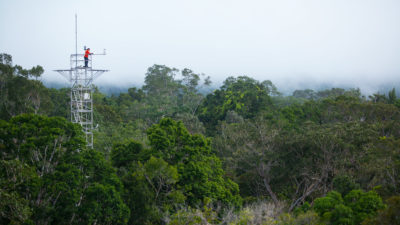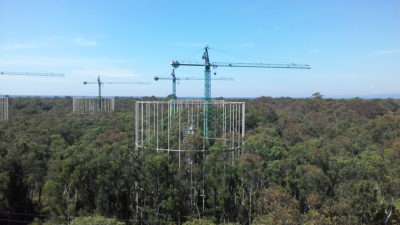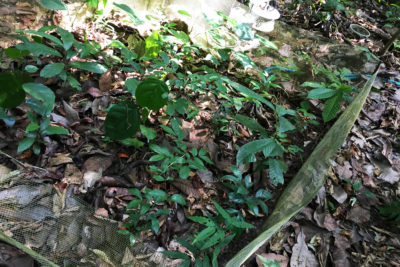In a eucalyptus forest just west of Sydney, Australia, six open towers made of 25-meter-tall white pipes poke above the treetops. In 2012, carbon dioxide gas started flowing from the tubes, raising levels inside the rings to nearly 40 percent above the global average CO2 concentration of around 405 parts per million. For four years, trees soaked in the carbon bath, building some of it into leaves, roots, and wood, and respiring the rest. When ecologist Mingkai Jiang of Western Sydney University and colleagues measured the results of all this activity, they were shocked. Despite gorging on plant food in the form of CO2, the trees hadn’t managed to grow any larger, the researchers reported in April in Nature.
Almost halfway around the world, wires snake through the leaf-strewn soil of Barro Colorado Island, Panama. Electricity coursed through the wires for two years, raising the soil temperature by 4 degrees Celsius, mimicking the possible future. The findings were, again, sobering: The warmed soil belched out 55 percent more carbon than a control plot that wasn’t warmed, suggesting that tropical soils could become a potent source of carbon dioxide in a warmer future.
Ever since global climate change was recognized as a major threat, scientists have struggled to determine how much carbon ecosystems, and forests in particular, can soak up from the atmosphere as both carbon dioxide levels and temperatures rise. Basic plant physiology and small-scale experiments with tree seedlings indicate that as carbon dioxide rises, so does photosynthesis, all else being equal. And up to a certain point, warmth also juices plant growth, as anyone who has grown plants in a greenhouse knows. Forests today absorb more than a quarter of humans’ CO2 emissions, and more than a trillion tons of carbon reside in trees and forest soil — more than twice the carbon emitted by humans since the Industrial Revolution began.
“It looks like the consequence of temperature outweighs the benefits of CO2,” says one expert.
But what will happen to that carbon in real ecosystems over the coming decades — as heat, droughts, fires, storms, and insect and disease outbreaks all worsen — is much more complicated. A new generation of field experiments and computer models are tackling some of the biggest open questions around the future of forests.
Their results seem to be converging on bad news: Higher CO2 concentrations do not necessarily accelerate forest growth, warming soils seem to emit substantially more CO2 than previously believed, and climate-driven scourges threaten to kill trees faster than they can grow, turning forests globally into sources, not sinks, of carbon. Most worryingly, higher temperatures themselves could cause physiological changes in plants that reduce their ability to photosynthesize and grow. “It looks like the consequence of temperature outweighs the benefits of CO2,” says Nate McDowell, an earth scientist at the Pacific Northwest National Laboratory in Richland, Washington.
The bottom line is that the changing climate is already hammering forests around the world, and future impacts could become severe enough to negate forests’ ability to sequester carbon altogether.
But some scientists worry that their peers are missing the enormous climate benefits that even compromised forests can provide. “I worry that our academic obsession with the declining sink will be misinterpreted by the public” to mean that keeping forests standing is unimportant, says Peter Ellis, a forest carbon scientist with The Nature Conservancy. “A ton of carbon in a forest is always a ton of carbon in a forest.”
Rings of white tubes pump elevated levels of CO2 onto eucalyptus trees at a research site near Sydney, Australia. Courtesy of Belinda Medlyn
Many scientists have argued that forests can maintain or even increase carbon sequestration by storing carbon in long-lived wood and roots, which, over the next few decades, could provide a substantial brake on climate change. No serious scientist has argued that such “natural climate solutions” absolve countries from cutting fossil fuel emissions, but some have hoped they could at least provide crucial breathing room to head off the worst impacts of climate change.
Several lines of evidence have supported this view. In free-air CO2 enrichment (FACE) experiments that flooded young forests in the Southeastern United States with high concentrations of CO2, trees accelerated their growth, at least until they hit another growth limit, such as soil nutrients. A major 2011 study found “a large and persistent carbon sink in the world’s forests” and attributed much of the sink to mature tropical and boreal forests. And studies based on measurements made by satellites have revealed a major greening of Earth’s surface since 1980, which some scientists interpreted as indicating that forests were soaking up large amounts of carbon from the atmosphere. Climate skeptics have sometimes jumped on these findings to cast doubt on the scientific consensus that global warming is a major threat.
While climate scientists roundly reject that view, many have enthusiastically promoted forests’ ability to soak up carbon. Last summer, the lead author of a much-celebrated paper called tree planting “the best climate solution available today,” though the authors later clarified that it can’t substitute for emissions reductions.
Now much of the optimism seems to be fading, as a growing set of studies document alarming increases in tree death from causes including deforestation, fires, droughts, and insect outbreaks. In the last two years, two papers based on long-term field data found that tree death was catching up with increased growth throughout the Americas. And a recent study of 300,000 trees, led by researchers at the University of Leeds in the United Kingdom and the Royal Museum for Central Africa, estimated that intact African forests’ capacity to remove carbon will decrease by 14 percent by 2030. The Amazon, meanwhile, could stop removing carbon dioxide altogether as early as 2035, as trees begin to die so quickly that forests start shedding carbon as fast as they pack it on. Others have found evidence that parts of the Amazon rainforest are already flipping from being carbon sinks to carbon sources.
A recent study found that trees in intact forests around the world are dying twice as fast as in the past.
Meanwhile, more careful analysis of satellite data by Boston University earth scientist Ranga Myneni and colleagues revealed that much of the greening seen in previous studies was due not to accelerated forest growth, but rather to an extensive, decades-long tree-planting initiative in China, coupled with rapid intensification of farming in China and India as growers gained access to capital and adopted fertilizer and irrigation on a wide scale.
In a study posted in May to a preprint server, and still awaiting peer review, Myneni’s team has gone farther, reporting that the long-term greening trend in satellite data may be starting to decline, consistent with on-site forest studies. “We already are beginning to see that there is an emerging browning signal,” Myneni says.
Two papers published in Science, one in May and one in June, sought to make sense of the various and sometimes contradictory evidence. Both found causes for alarm.
The authors of the May paper, who analyzed previous studies and tree demography data sets, reported that trees in intact forests around the world are dying twice as fast as in the past, reducing both how much carbon such forests can absorb and how long that carbon stays locked away.
While fires, droughts and other factors are playing a role, forests also seem to be switching from a period dominated by carbon fertilization to one dominated by a phenomenon known as vapor pressure deficit, says Pacific Northwest National Lab’s McDowell, who led the study. Vapor pressure deficit quantifies the difference between how much water the air can hold and how much it does hold at a given location and time. When vapor pressure deficit rises — for example, when temperature increases without a concomitant bump in humidity — plants avoid water loss by closing their stomata, the mouth-like cells in leaves that let water out and carbon dioxide in. That slows photosynthesis and, over the long term, growth and CO2 absorption.
Scientists Bruno Portela and Iain Hartley extract data from a soil moisture probe as part of the AmazonFACE project. João M. Rosa/AmazonFACE
Vapor pressure deficit “is what plants are really responding to,” McDowell says. “It’s arguably the most key variable that’s driving, globally, a trend in mortality.”
The other Science paper, published in June, adds an explicit warning for governments and other entities hoping to fight climate change through programs to plant trees or restore forests. “Climate-driven risks may fundamentally compromise forest carbon sinks in the 21st century,” the authors write.
“If we completely ignore the risks to forests from these climate-driven disturbances,” says William Anderegg, a biologist at the University of Utah who led the study, “they could more than cancel out the carbon sequestration effects of a given policy.”
Still, despite recent progress with forest data sets and satellite studies, scientists have found their predictions hampered by a shortage of experiments that can show how real-world forests will react to future conditions. Such experiments are expensive, time-consuming, and logistically fraught — especially in the tropics, where intense humidity and rainfall can damage equipment, as can animals. “Everything is working against you there,” says Katrin Fleischer, an ecologist at the Technical University of Munich in Germany.
The effort to warm tropical soils illustrates the challenges. Andrew Nottingham, an ecologist at the University of Edinburgh in the U.K., launched the Panama study to fill a major gap in the scientific literature: Dozens of soil warming experiments in temperate and boreal forests had found increasing carbon losses, but about a third of all forest soil carbon is in the already-warm tropics. Nottingham got permission to wire up a piece of ground at the venerable Smithsonian Tropical Research Institute, which sits in the Panama Canal zone. After collecting and analyzing two years’ worth of data, he found that soil emissions had soared by more than half, an effect not predicted by theory. His study will be published soon. “[Climate] models are missing a large source of CO2 under warming from tropical soils,” Nottingham says.
Regardless of how much carbon forests suck up in the future, retaining forests is critical to climate stabilization.
The study outside of Sydney was one of the first carbon-fertilization experiments done in a mature forest anywhere. Three rings of pipes pumped out carbon dioxide while three others did not, serving as a control; a further three control areas had no rings at all. For four years, the scientists tracked the carbon as it moved through the trees’ leaves, stems, and roots. About half the additional carbon made its way into the soil and was respired back to the atmosphere by microbes; most of the rest was respired by the trees themselves, similar to how our exhalations release CO2. The trees grew no more in the experimental plots than in the control plots.
The experiment yielded one of the starkest pieces of evidence yet against a carbon fertilization effect in mature forests. (A previous study done in a mature deciduous forest in Switzerland arrived at a similar result, but that experiment piped carbon dioxide only onto tree stems, not an entire forest.) A third carbon-enrichment experiment near Birmingham in the U.K. has been running for more than three years, and will add additional data.
Even these experiments won’t answer all questions, though. The forests studied so far are relatively monotonous — the Sydney forest is dominated by just one species, eucalyptus —whereas in some tropical forests, more than 200 tree species can mingle in a single hectare. These forests are also warm and sun-bathed year-round, pumping up growth rates.
For that reason, a group of researchers has sought for years to build a FACE experiment near Manaus, Brazil, in the heart of the Amazon, to examine how mature, mega-diverse tropical forests will grow in a carbon-rich future. Among the important questions is what role phosphorus-depleted soils — common in tropical forests but not elsewhere — play in regulating forest growth.
Researcher Andrew Nottingham at a study site on Barro Colorado Island, Panama. The experiment raised the soil temperature by 4 degrees C to mimic future conditions and tracked carbon output. Courtesy of Smithsonian Archives
“As long as we do not experiment with the forests in a systematic and controlled way, I don’t think we’ll be able to reduce the uncertainty,” says David Lapola, a climate scientist at the University of Campinas in Brazil who is leading the Amazon FACE effort. Uncertain funding and the anti-science regime of Brazilian President Jair Bolsonaro have complicated the effort, but a potential partnership between Brazilian and German funders, with details still to be worked out, has given new life to the multi-million dollar project, Lapola says.
Ultimately, insights from experiments, satellite studies, and forest plot networks flow into enormously complex earth-system models that groups such as the Intergovernmental Panel on Climate Change (IPCC) use to forecast future climate change. The generation of models currently being assessed for the next IPCC report, due next year, have improved dramatically over several decades. They now explicitly represent numerous forest types, and many include dynamic nitrogen cycles and improved tree mortality statistics.
As a result of remaining uncertainties, however, some earth-system models project that in 2100, terrestrial ecosystems could sequester as much as 36.7 billion tons of carbon dioxide per year — about four times as much as they do now — whereas others forecast a release of as much as 22 billion tons. That huge range of 59 billion tons far exceeds today’s annual global emissions from all sources, and could make the difference between a dire but manageable climate and global catastrophe.
Regardless of how much carbon forests will suck up in the future, keeping forests standing and growing remains critical to climate stabilization, says Ellis of The Nature Conservancy, which has strongly promoted natural climate solutions to store carbon in forests, farmland and other ecosystems. His team has limited its estimates of such solutions’ potential to carbon they feel is reasonably certain to stay locked up, and has not counted on additional carbon from CO2 fertilization. He worries that further haggling over scientific details could delay implementation of proven solutions.
But the University of Utah’s Anderegg cautions that if organizations promoting natural climate solutions do not account better for future risks to standing forests, their efforts may end up doing little or nothing to fight climate change.
“I’m wary of us jumping in too fast without the best science to guide our policies and our actions,” Anderegg says. “I would much rather see us do this right and a little bit slower, than do it fast and do it poorly.”







